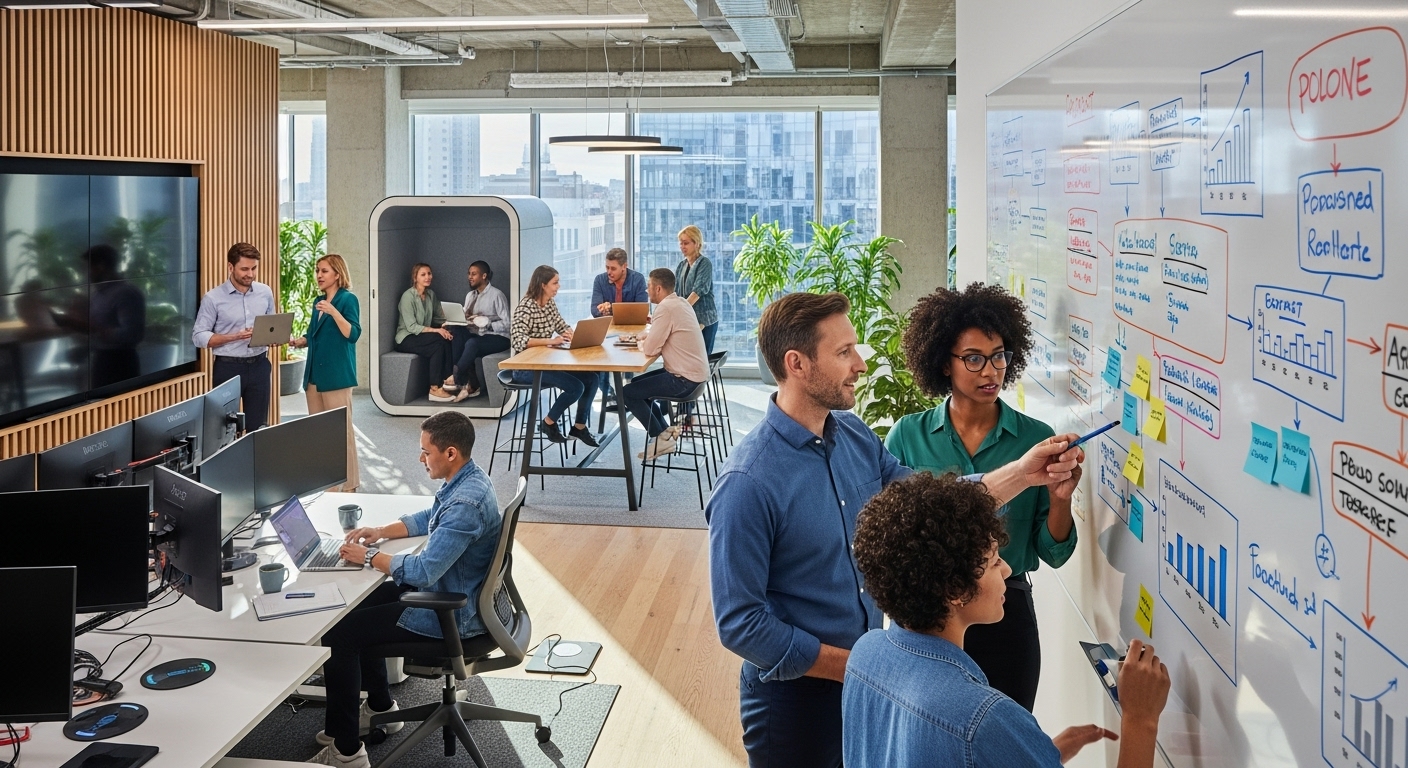In today’s competitive landscape, the pursuit of employee productivity often devolves into a frantic cycle of more meetings, more notifications, and more pressure. This approach mistakes activity for achievement, leading teams toward burnout, not breakthrough performance. The real challenge isn’t pushing people to work harder, but creating an environment where high-impact work happens naturally. Recent trends show a clear shift away from traditional, input-based metrics (like hours logged) towards outcome-focused, sustainable productivity. This is where the Velocity Code comes in—a holistic framework for engineering a work environment designed for speed, focus, and long-term success. It’s not about cracking a whip; it’s about removing friction and building momentum. This guide will walk you through the core components of the Velocity Code, from establishing psychological safety as a performance multiplier to implementing deep work rituals and measuring what truly matters. By focusing on the system, not just the individual, leaders can unlock a new level of team performance that is both fast and sustainable.
The Foundation of Speed: Psychological Safety as a Performance Multiplier
The single greatest accelerator for any team is not a new piece of software or a productivity hack; it’s psychological safety. This concept, famously highlighted by Google’s Project Aristotle research, is the shared belief that team members can take interpersonal risks without fear of negative consequences. When safety is high, hesitation disappears. Employees feel empowered to ask questions, challenge the status quo, admit mistakes, and pitch nascent ideas—actions that are crucial for innovation and rapid problem-solving. In an unsafe environment, team members waste enormous amounts of time and energy on self-preservation: managing perceptions, avoiding blame, and navigating political minefields. This ’emotional tax’ is a direct drag on velocity. True speed is born from clarity and confidence, not fear. To build this foundation, leaders must be intentional. It starts with modeling vulnerability by admitting their own mistakes and uncertainties. It involves framing work as a series of learning challenges rather than execution tests, which destigmatizes errors. Furthermore, fostering an environment of active listening and intellectual curiosity, where questions are rewarded over silent compliance, encourages the open dialogue necessary for quick course corrections and collective intelligence. Ultimately, a psychologically safe team doesn’t have to slow down for politics, making them faster, more agile, and more resilient in the face of complex challenges.
Calibrating the Digital Cockpit: Tools for Focus, Not Friction
In the modern workplace, technology is a double-edged sword. While tools for communication and project management promise efficiency, their unchecked proliferation often leads to a state of perpetual distraction and cognitive overload. The constant barrage of notifications from Slack, email, Asana, and a dozen other apps creates what is known as ‘tool friction’—the mental energy wasted on switching contexts and managing digital noise. The solution isn’t to add more tools, but to curate and calibrate a ‘digital cockpit’—a streamlined, integrated set of technologies designed to enhance focus. This requires establishing crystal-clear communication protocols. For instance, a team might decide that Slack is for urgent, synchronous queries that require a quick response, email is for non-urgent, asynchronous updates, and a project management tool is the single source of truth for task status. This simple act of defining channels reduces decision fatigue. Another crucial step is to leverage automation to eliminate low-value, repetitive tasks that drain mental bandwidth. Automating meeting reminders, data entry, or report generation frees up employees to concentrate on complex problem-solving. The goal is to design a digital environment where technology serves as a quiet, efficient copilot rather than a backseat driver yelling for attention. By intentionally reducing digital friction, teams can reclaim their focus and channel their energy into the work that drives meaningful output.
Designing for Deep Work: Architecting Your Physical and Virtual Spaces
An employee’s environment, whether physical or virtual, is a powerful determinant of their ability to achieve a state of ‘deep work’—the focused, uninterrupted concentration that produces high-value output. Architecting spaces that facilitate this state is a critical component of the Velocity Code. In a physical office, this means moving beyond the one-size-fits-all open-plan layout. A well-designed workspace offers a spectrum of environments, from vibrant, collaborative hubs for brainstorming and social connection to quiet, library-like zones and private pods for heads-down, focused tasks. This ‘activity-based working’ model empowers employees to choose the space that best suits their task at hand, minimizing distractions and maximizing flow. For remote and hybrid teams, the principles are the same, but the application differs. It involves creating a ‘virtual’ architecture through clear norms and expectations. This includes establishing core collaboration hours alongside protected focus time where meetings and non-urgent messages are discouraged. Leaders should encourage remote employees to create physical boundaries, such as a dedicated workspace, and digital boundaries, like turning off notifications outside of working hours. An ‘asynchronous-first’ mindset is key here, designing workflows that don’t depend on immediate responses, which allows for deep work to happen across different time zones and schedules. By thoughtfully designing both physical and digital spaces, organizations provide the essential infrastructure for sustained focus and high-quality work.
Engineering Focus: Implementing Rituals for Uninterrupted Workflow
While the right environment is crucial, protecting focus requires more than just physical or digital architecture; it demands collectively adopted processes and rituals. Focus is a finite resource that is easily depleted by constant context switching. Engineering a culture of focus means making deep work a team sport, not an individual struggle. One of the most effective strategies is time blocking at a team level. This can take the form of ‘no-meeting’ days or establishing ‘core focus hours’—for example, from 9 AM to 12 PM every day—where the entire organization agrees to avoid scheduling meetings or sending non-critical communications. This collective commitment protects everyone’s most productive time and signals that the organization values deep work. Another powerful technique is the implementation of start-of-day and end-of-day rituals. A 10-minute ‘startup’ ritual, where team members review their priorities and plan their day, can create clarity and intention. Similarly, a ‘shutdown’ ritual, where employees review what they accomplished, plan for the next day, and officially sign off, helps create a psychological boundary between work and personal life. This prevents work from bleeding into evenings and reduces the mental clutter that can hinder rest and recovery. By embedding these rituals into the team’s weekly cadence, focus becomes a predictable and protected part of the workflow, enabling team members to consistently perform at their cognitive best.
The Feedback Accelerator: Using Continuous Loops to Refine Performance
In a high-velocity environment, waiting for an annual performance review to course-correct is like trying to steer a speedboat with a map from last year. Speed and agility depend on tight, continuous feedback loops that allow for real-time adjustments. Traditional feedback mechanisms are often too slow, too formal, and too emotionally charged to be effective. The goal is to make feedback a normal, frequent, and low-stakes part of the daily workflow. Frameworks like Kim Scott’s ‘Radical Candor’—caring personally while challenging directly—provide a mental model for delivering guidance that is both kind and clear. Leaders can foster this by creating multiple, lightweight channels for feedback. This could include dedicating the last five minutes of a weekly team meeting to ‘pluses and deltas’ (what went well, what could be improved), implementing regular project retrospectives after a milestone is reached, or using simple polling tools in Slack to get a quick pulse on specific issues. The key is to shift the perception of feedback from a dreaded event to a valuable tool for learning and acceleration. When feedback is immediate and focused on the work rather than the person, it becomes a powerful engine for skill development, process refinement, and faster problem-solving. This continuous flow of information ensures the team is always learning, adapting, and refining its approach, which is the very essence of sustainable velocity.
Measuring What Matters: Metrics Beyond Motion and Meetings
The adage ‘what gets measured gets managed’ holds true for productivity, but many organizations fall into the trap of measuring the wrong things. Tracking vanity metrics like hours worked, emails sent, or tasks completed creates a culture of ‘performative busyness’ where employees optimize for looking busy rather than creating value. To truly understand and improve team velocity, leaders must focus on metrics that reflect actual output and sustainable performance. These can be broken down into three key areas. First are project and process metrics, such as ‘cycle time’ (the time from starting work on a task to completing it) and ‘lead time’ (the total time from request to delivery). Reducing these times indicates a genuine increase in efficiency. Second are quality and value metrics. This includes tracking things like customer satisfaction scores (CSAT), Net Promoter Score (NPS), or the rate of defects or rework required. High velocity is meaningless if the quality of the output is poor. Finally, it’s critical to measure team health and sustainability through metrics like employee Net Promoter Score (eNPS) and qualitative surveys on burnout and engagement. A spike in output accompanied by a crash in team morale is not a win; it’s a debt that will soon come due. By adopting a balanced scorecard that tracks speed, quality, and well-being, leaders gain a true picture of performance and can make informed decisions that boost productivity without sacrificing their team’s long-term health.
Conclusion
Boosting employee productivity is not a matter of simply demanding more; it is a complex engineering challenge. The Velocity Code offers a strategic blueprint for moving beyond the outdated notion of productivity as a function of effort and into a modern understanding of productivity as a function of the work environment. By systematically addressing the core pillars of this framework, leaders can create the conditions for success. It begins with building a foundation of psychological safety, which unleashes the speed that comes with fearless collaboration. It continues with intentionally designing a digital cockpit and physical spaces that minimize friction and maximize focus. This environment is then activated by team-wide rituals that protect deep work and feedback loops that accelerate learning and course correction. Finally, it is all guided by a commitment to measuring what truly matters: a combination of speed, quality, and team well-being. The role of a modern leader is shifting from that of a supervisor to an architect—an engineer of environments where talented people can do their best work. By embracing the Velocity Code, you are not just chasing efficiency; you are building a resilient, high-performing culture capable of sustained output and innovation in the long run.





